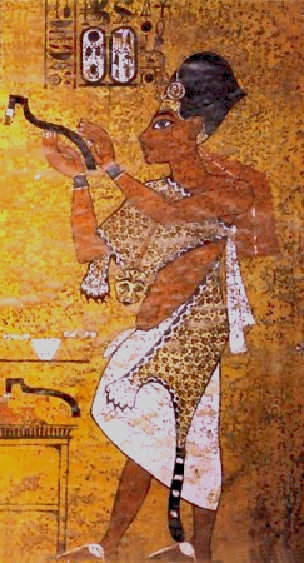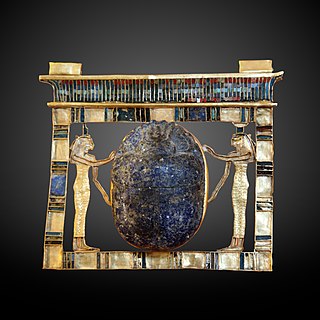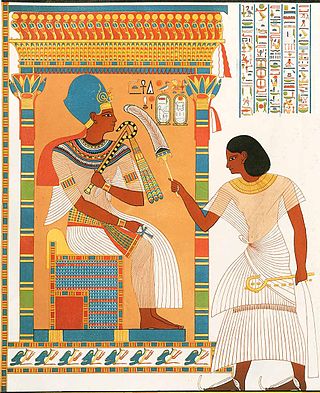Related Research Articles

Horemheb, also spelled Horemhab or Haremhab, was the last pharaoh of the 18th Dynasty of Egypt. He ruled for at least 14 years between 1319 BC and 1292 BC. He had no relation to the preceding royal family other than by marriage to Mutnedjmet, who is thought to have been the daughter of his predecessor Ay; he is believed to have been of common birth.

Ay was the penultimate pharaoh of ancient Egypt's 18th Dynasty. He held the throne of Egypt for a brief four-year period in the late 14th century BC. Prior to his rule, he was a close advisor to two, and perhaps three, other pharaohs of the dynasty. It is speculated that he was the power behind the throne during child ruler Tutankhamun's reign. His prenomenKheperkheperure means "Everlasting are the Manifestations of Ra," while his nomenAy it-netjer reads as "Ay, Father of the God." Records and monuments that can be clearly attributed to Ay are rare, both because his reign was short and because his successor, Horemheb, instigated a campaign of damnatio memoriae against him and the other pharaohs associated with the unpopular Amarna Period.

Aspelta was a ruler of the kingdom of Kush. More is known about him and his reign than most of the rulers of Kush. He left several stelae carved with accounts of his reign.

Shebitku also known as Shabataka or Shebitqo, and anglicized as Sethos, was the second pharaoh of the Twenty-fifth Dynasty of Egypt who ruled from 714 BC – 705 BC, according to the most recent academic research. He was a son of Piye, the founder of this dynasty. Shebitku's prenomen or throne name, Djedkare, means "Enduring is the Soul of Re." Shebitku's queen was Arty, who was a daughter of king Piye, according to a fragment of statue JE 49157 of the High Priest of Amun Haremakhet, son of Shabaka, found in the temple of the Goddess Mut in Karnak.
The former Kingdom of Kerma in Nubia, was a province of ancient Egypt from the 16th century BCE to eleventh century BCE. During this period, the polity was ruled by a viceroy who reported directly to the Egyptian Pharaoh. It is suggested by some scholars that the Kushite rulers of Egypt's 25th Dynasty were descendants of these viceroys, and that so were the dynasties that ruled independent Kush until the fourth century CE.

Maya was an important figure during the reign of Pharaohs Tutankhamun, Ay and Horemheb of the Eighteenth Dynasty of Ancient Egypt. Maya's titles include: fan bearer on the King's right hand, overseer of the treasury, chief of the works in the necropolis, and leader of the festival of Amun in Karnak.

Gebel el-Silsila or Gebel Silsileh is 65 km (40 mi) north of Aswan in Upper Egypt, where the cliffs on both sides close to the narrowest point along the length of the entire Nile. The location is between Edfu in the north towards Lower Egypt and Kom Ombo in the south towards Upper Egypt. The name Kheny means "The Place of Rowing". It was used as a major quarry site on both sides of the Nile from at least the 18th Dynasty to Greco-Roman times. Silsila is famous for its New Kingdom stelai and cenotaphs.

Paser was an ancient Egyptian noble who served as vizier during the reigns of Seti I and Ramesses II in the 19th Dynasty. He would later also become High Priest of Amun.

Nakhtmin held the position of generalissimo during the reign of pharaoh Tutankhamun of the Eighteenth Dynasty of Ancient Egypt. His titles during the reign of Tutankhamun included "the true servant who is beneficial to his lord, the king's scribe," "the servant beloved of his lord," "the Fan-bearer on the Right Side of the King," and "the servant who causes to live the name of his lord." These titles were found on five ushabtis that Nakhtmin offered as funerary presents for pharaoh Tutankhamun.

Merymose, also Mermose or Merimes, was a Viceroy of Kush under Amenhotep III. He served for almost the entire four decades of that reign.

Amenhotep called Huy was Viceroy of Kush under Tutankhamen. He was the successor of Tuthmosis, who served under Akhenaten. He would later be succeeded by Paser I.

Amenemopet served as Viceroy of Kush during the reign of Seti I.
Heqanakht was Viceroy of Kush during the reign of Ramesses II. His titles include: King's son of Kush, overseer of the Southern Lands, Fan-bearer on the Right Side of the King, Messenger to every land, Hereditary prince, royal sealbearer.
in Ancient Egypt, Paser II was the son of the High Priest of Min and Isis named Minmose. Paser came from a very well-connected family. One uncle was the High Priest of Amun Wennenefer and another uncle was the troop commander of Kush named Pennesuttawy. Through Wennenefer, Paser was related to Amenemone, Amenemope and Hori, the High Priest of Anhur.
Huy was Viceroy of Kush during the reign of Ramesses II. He may have served either before or after Setau. Huy was also Mayor of Tjarw and a royal messenger to the Hatti.
Tuthmose was the Viceroy of Kush during the reign of Akhenaten. Tuthmose was given the titles King's Son of Kush, Overseer of the Gold Lands of Amun, Overseer of masons, Overseer of the borderlands of His Majesty, and Fan-bearer on the King's right.

The Viceroy of Kush Seti is attested in year 1 of Siptah. Seti is also mentioned on some monuments of his son Amenemhab. Amenemhab was the son of Seti and the Lady Amenemtaiauw. Seti held the titles fan-bearer on the king's right, and king's scribe of the letters of the Pharaoh. His son Amenemheb served as Head Bowman, Charioteer of His Majesty, and Overseer of the Southern Lands.

Wentawat, was Viceroy of Kush under Ramesses IX, during the 20th Dynasty. He was a son of the Viceroy Nahihor.

The Theban Tomb TT383 is located in Qurnet Murai, part of the Theban Necropolis, on the west bank of the Nile, opposite to Luxor. It is the burial place of the ancient Egyptian Viceroy of Kush named Merymose, who lived during the 18th Dynasty and served under Amenhotep III.
Hori was a High Priest of Anhur during the reign of Ramesses II. He was the son of the High Priest of Amun Parennefer called Wennefer and his wife Isis. He may be identical to the High priest of Amun mentioned on the statue of the Overseer of the Charioteers named Kanakht.
References
- 1 2 3 4 5 The Viceroys of Ethiopia by George A. Reisner The Journal of Egyptian Archaeology, Vol. 6, No. 1. (Jan., 1920), pp. 38-39.
- ↑ Porter, B. and Moss R.L.B., Topographical Bibliography of Ancient Egyptian Hieroglyphic Texts, Reliefs and Paintings: The Theban Necropolis, Part One: Private Tombs. Second Edition. Griffith Institute. Oxford. 1994
- ↑ PM VII, 81
- ↑ G. Steindorff, Aniba II, 1937 p.25 pl 12 No 43
- ↑ Cathie Spieser, Les noms du Pharaon comme êtres autonomes au Nouvel Empire,(OBO, 174) Friburg/Göttingen 2000, 191, 295 No 28.